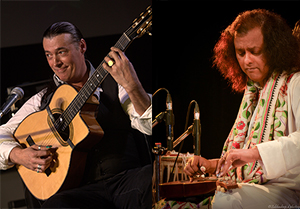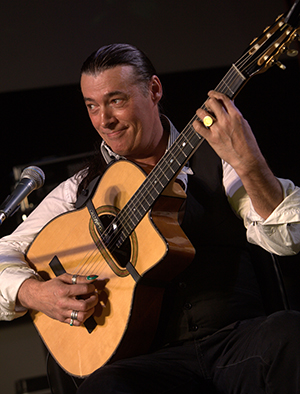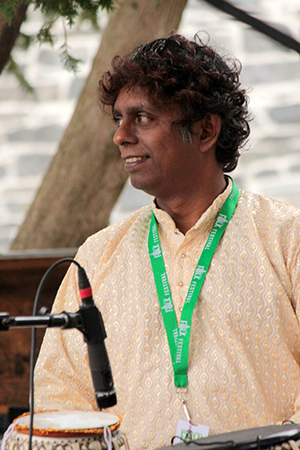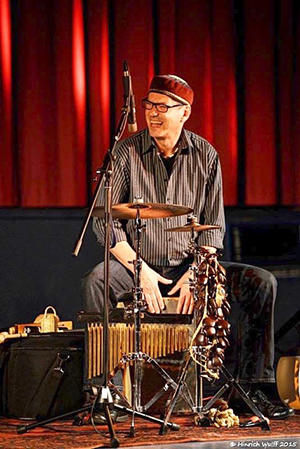
 The original Gypsies came from the Rajastan region of India before migrating north and west, eventually centering in Europe and developing a distinctive uptempo musical style, while in India classical raga music arose to express the people's intense spirituality. After many
The original Gypsies came from the Rajastan region of India before migrating north and west, eventually centering in Europe and developing a distinctive uptempo musical style, while in India classical raga music arose to express the people's intense spirituality. After many
years and many permutations, GYPSY MEETS INDIA reunites the current music of these two rich musical cultures once again.
GYPSY MEETS INDIA is the brainchild of guitar icons LULO REINHARDT and DEBASHISH BHATTACHARYA. Combining Gypsy Swing from Europe with Raga Music from India in a free-flowing set of new compositions, Lulo and Debashish are joined by vocalist ANANDI BHATTACHARYA and percussionists ULLI KRAMER and SUBHASIS BHATTACHARYA.
 Django Reinhardt left behind an indelible musical legacy, introducing and defining a passionate style of Gypsy Jazz guitar that was astonishing in the 1930's and is still revered and emulated today. Born to a Gypsy family in Belgium, Django's playing inspired his extended family in Germany and France, and successive generations of Reinhardts have reinforced his powerful musical vision and added their own ideas. LULO REINHARDT, Django's grand nephew, is a third generation master from Germany. He has retained the incredible Reinhardt soul, speed and dexterity and updated the repertoire.
Django Reinhardt left behind an indelible musical legacy, introducing and defining a passionate style of Gypsy Jazz guitar that was astonishing in the 1930's and is still revered and emulated today. Born to a Gypsy family in Belgium, Django's playing inspired his extended family in Germany and France, and successive generations of Reinhardts have reinforced his powerful musical vision and added their own ideas. LULO REINHARDT, Django's grand nephew, is a third generation master from Germany. He has retained the incredible Reinhardt soul, speed and dexterity and updated the repertoire.
Lulo Reinhardt was first taught by his father at the age of five. At twelve, he played in the Mike Reinhardt Sextett and later co-founded the group, “Django Reinhardt and the Heartbreakers.” In 1991, he founded “I Gitanos” with his father Bawo and cousin Dege, touring throughout Europe and first establishing his national reputation.
Lulo is a spontaneous and spirited musician. His curiosity took him to southern Spain in search of flamenco roots, and to South America, exploring various musical styles of Latin Jazz. By 2002, he was ready to take his place as a bandleader, founding the Lulo Reinhardt Project. They recorded the highly-acclaimed Project No. 1 in 2002, andProject No. 2 in 2005, reflecting his passion for Latin music.
In 2007, Saga Instruments of San Francisco CA made the first Lulo Reinhardt Model Gitane 310, modeled on the classic Gypsy guitars. This inspired Lulo to compose more Swing material, which he combined with Latin music, and in 2007 changed the name of his group to the Lulo Reinhardt Latin Swing Project. They recorded their first CD in 2008.
In the beginning, he played in Europe with an all-German band but later spent considerable time in Australia, forming a new band of German and Australian musicians. They have recorded several CD's, and toured extensively internationally. In additional to annual Australian tours beginning in 2008, they have played in the United States, China, France, Switzerland, Belgium, England, the Czech Republic, Scotland and Germany.
Lulo has performed on multiple tours as a soloist with International Guitar Night between 2009 and 2016, in the U.S., Canada, the U.K. and Germany. He will return as the artistic director, host and performing guitarist for the 2017 and 2018 IGN tours.
 Kolkata, India’s Debashish Bhattacharya started learning Indian music from his parents before he learned the alphabet. In his childhood he mastered many Indian classical instrumental styles as well as vocal music from different musical teachers in Calcutta. He became a disciple and student of Brij Bhushan Khabra, the father of Indian classical guitar, for 10 years, and also trained under Ajoy Chakraborty, the eminent Indian vocalist. He has also studied with Ustad Ali Akbar Khan.
Kolkata, India’s Debashish Bhattacharya started learning Indian music from his parents before he learned the alphabet. In his childhood he mastered many Indian classical instrumental styles as well as vocal music from different musical teachers in Calcutta. He became a disciple and student of Brij Bhushan Khabra, the father of Indian classical guitar, for 10 years, and also trained under Ajoy Chakraborty, the eminent Indian vocalist. He has also studied with Ustad Ali Akbar Khan.
As a performer, Debashish gave his first guitar recital at the age of four on the All India Radio, and in a public concert. In his twenties, he evolved a unique style of playing guitar, synthesizing selected features of various other instruments such as the Veena, Sitar, Sarod and Kannur. In 1984, he was awarded the President of India award at the age of 21.
Debashish developed his innovative Hindustani slide guitar after years of research and experience. It consists of a Hofner acoustic F hole guitar, with a total of 22 strings. He added a platform of wood running the length of the guitar's neck, mounted with 17 tuning gears. This piece of wood extends the width of the neck, making room for twelve sympathetic strings, and five supporting strings for additional versatility. Above the 5 normal (sliding melody) strings, there is a pair of ckikari strings, as on a sitar. One of Debashish's innovations was to move them to the treble side of the guitar, which enables far more complex playing, since their rhythmic drones can be played by the fingers, over other melodies simultaneously. Debashish plays this guitar while sitting cross legged, with the guitar held on the lap and played with a small steel bar, metal picks and a celluloid thumb pick.
Debashish is perhaps the greatest slide guitarist in India. He has, both through creating the actual design of the instrument, and through his incredible talent and discipline, elevated the Hindustani slide guitar to be the highest evolution of slide guitar anywhere. Though he is often compared to V.M. Bhatt, there is little basis for comparison, because Debashish's music has far greater musical range, physical dexterity, and emotional depth. To develop his playing, he has undergone decades of disciplined study of Indian vocal technique combined with his instrumental work. Debashish can sing perfectly in parallel with every blindingly fast melody he plays. Possessed of a very open musical mind, Debashish is eager and more than qualified to collaborate and truly blend with musicians from any other country.
 Anandi Bhattacharya is a child prodigy in a family filled with illustrious musicians and singers. Her father, slide guitar master Debashish Bhattacharya, has been her constant guide, teaching her to hone her skills in understanding music. She inherited the golden voice of her grandmother, whose music grew and was nurtured within the family. Sukanya started training under her aunt Sutapa Bhattacharya at the age of three. She gave her first radio performance at the age of four.
Anandi Bhattacharya is a child prodigy in a family filled with illustrious musicians and singers. Her father, slide guitar master Debashish Bhattacharya, has been her constant guide, teaching her to hone her skills in understanding music. She inherited the golden voice of her grandmother, whose music grew and was nurtured within the family. Sukanya started training under her aunt Sutapa Bhattacharya at the age of three. She gave her first radio performance at the age of four.
She began training under Vidushi Shubhra Guha at the age of twelve. Her singing is a mixed style of Agra, Patiala and Maihar schooling. Though she is a young singer, born in 1996, she has already been attempting songs from various genres of Indian music, Bollywood music, and popular western numbers. Yet she dreams of imbuing the cultural ethos of India in her presentation of music. She has already started touring with her father and has presented an experimental programme on Tagore’s songs and raga music inter-phase. Her tone and timbre, and her intellect, portend a bright future for this precocious young singer.
 Subhasis is a leader of his generation of Indian percussionists. As the younger brother of Debashish, Subhasis grew up steeped in the deep musical background of the Bhattacharya family, learning melody and rhythm from infancy. His father Sri Sunil Bhattacharya taught him tabla and his mother, vocalist Smt. Manjushree Bhattacharya worked with him melodically when he was a toddler.
Subhasis is a leader of his generation of Indian percussionists. As the younger brother of Debashish, Subhasis grew up steeped in the deep musical background of the Bhattacharya family, learning melody and rhythm from infancy. His father Sri Sunil Bhattacharya taught him tabla and his mother, vocalist Smt. Manjushree Bhattacharya worked with him melodically when he was a toddler.
He started to make his presence felt in the music scene from childhood as a promising tabla player trained by teachers Sri Prabir Bhattacharya and Pt. Shyamal Bose. Now, he is considered to be a master player, and he continues to study with Pandit Anindo Chatterjee, the senior tabla maestro. He has regularly performed in every major Indian music festival, and has recorded four albums with Debashish and seven albums with Pandit Ajoy Chakrabarty.
Subhasis first toured outside of India in 1996 with Debashish and Bob Brozman. His skill and flexibility as percussionist on several instruments, rhythm arranger, and vocalist have since been heard on subsequent overseas tours in the USA, Canada, South Africa, Greece, Kuwait, Bangladesh, and Nepal. A leading studio musician in India, he has begun creating and leading large percussion ensembles, and his arranging skills are essential to the music on this album, as an equal participant in its creation. With meticulously tuned hand drums, he played intricate rhythms, plus melodic parts inside the rhythm section. Creating percussion landscapes by playing several instruments on multiple tracks gave Subhashis a sense of liberty, yielding one creative explosion after another.
Uli started playing the drums at the age of 12 years.
 After studying 2 years of classical drums, he took privat lessons with PETER GIGER, TRILOK GURTU and GARY CHAFFEE.
After studying 2 years of classical drums, he took privat lessons with PETER GIGER, TRILOK GURTU and GARY CHAFFEE.
The following years he played in different Jazz-, Rock-, Punk-,
Pop- and Latin Bands.
In 1986 he got a golden record with the belgian Popband 2 BELGEN.
He also played and recorded with CHARLIE MARIANO, QUIQUE SINESI, NICKY MARRERO, THE WEATHER GIRLS, ALEX ACUNA, THOMAS ANDERS ( Modern Talking )
Since 1993 he plays and tours with LULO REINHARDT in
different bands and as a Duo.
In 2002 he joined the Latin Pop Band MENINO and toured with
them in Europe and South Africa.
Since 2014 he also plays with ROSCO GEE ( Traffic, Stevie Winwood, Can, Al Di Meola, ) and recorded the CD MY NAME IS FEAR.
Uli not only plays the drumset but also Cajon , Udu ( Claydrum ) and uses many different small Percussion Instruments.
 |
 |
 |
 |
 |
 |
 |
GYPSY MEETS INDIA will be touring North America in support of their
collaborative CD in the Fall of 2019.